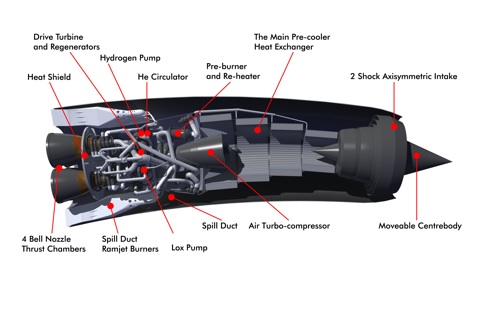If there is one technology above all which symbolises the revival of a strong British space sector it is launchers. We opted out of launchers in the early 1970s when we instead provided the core technologies for what has become the Arianne programme. Arianne is a reliable and effective conventional launch system. But the world is changing and we want to see Britain at the forefront of the next generation of launch and propulsion technologies. We can skip that generation of technologies and lead the move to the next stage.
That is why the Chancellor announced last month that the Government will invest in the development of the Synergetic Air-Breating Rocket Engine (SABRE) - an engine which could transform how we think about both space and aviation. £60 million has been committed to begin building the SABRE prototype, to make the technology available to the market and ultimately, to ensure the future of the UK economy.

This is a unique invention. The SABRE engine is the only one of its kind that is being developed in the world at the present time. What sets this engine apart is its game-changing heat exchange technology, which cools air from 1000°C to -150°C in one hundredth of a second, despite weighing little more than a tonne. It means that what once seemed impossible – an affordable and re-usable service into orbit – is now within reach.
‘SABRE has the power to revolutionise our lives in the 21st century. Alan Bond is a modern-day Frank Whittle, the British inventor of the jet engine
SABRE has the potential to create 20,000 high value engineering and manufacturing jobs. It will give the UK a leading position in a launcher market that is estimated conservatively to be worth £14 billion over the next thirty years. And it has the power to revolutionise our lives in the 21st century in the way that the jet engine did in the 20th century. That makes Alan Bond a modern day Frank Whittle, the British inventor of the jet engine.

Whittle first patented his design in 1930, despite a resounding absence of enthusiasm from the RAF. But his plane was not ready for testing for more than a decade, because the development tap was perpetually being turned on and off by the ministry and frightened bankers.
The most instructive chapter in Whittle’s story for us today was the arrival of Henry ‘Hap’ Arnold, Chief of Staff of the US Army Corps, in the UK on a fact-finding mission in 1941. Arnold heard that Whittle’s W1X engine was about to fly, and duly whisked it over to the US. Initially there was a strict agreement that it would be used for war purposes only. But after the war, in the interests of smoothing friendships, the UK Government released them of this undertaking for a neat $800,000 – and sealed America’s entry into the jet age.
This is where our new story will be different. While we let the turbojet engine technology slip through our fingers, this time the government is certainly not prepared to lose the engine technology that could revolutionise access to space. Our £60 million support means that Alan Bond’s team will now be able move to the next phase in the development here in the UK. I can announce today that we are committing £35 million in 2014-15, and £25 million in 2015 to 2016.
Over the next four years, the government’s money will be spent on four major elements of the SABRE engine development each of which is critical to realising the full production engine design at the end of the project:
- The heart of the investment will be the SABRE engine technical design work
- Improving the lightweight heat exchanger technology and manufacturing capability
- A flight test of the innovative rocket nozzle design for SABRE
- A significant part of the programme will be a ground demonstration of the engine
Reaction Engines has done a great deal of planning to prepare for this next phase, and with a project like this, timelines can change. But we expect to see the completion of prototype SABRE by 2017, and flight tests around 2020. Our investment will help to prime the pump for further commercial investment to supply the remainder of the capital needed for full engine development. The commercial investment will look to capture several times this initial £60 million investment as part of a three to five year programme, and the company is already generating additional interest from around the world.
‘While we let the turbojet engine technology slip through our fingers, this time the government is certainly not prepared to lose the engine technology that could revolutionise access to space
Our commitment to Reaction Engines is just part of a new era for propulsion in Britain.
I recently visited Qinetiq in Farnborough, and saw their contribution to our mission to Mercury, BepiColombo. The ion engines they have designed will take that spacecraft to the most difficult place to reach in our solar system. So British technology could one day take you from the surface of the Earth to the far reaches of our Solar System.
Companies like Moog ISP has been building space propulsion engines in Britain for years. And now European Space Propulsion, a subsidiary of the largest space propulsion company in the world - Aerojet Rocketdyne - has recently set up in Northern Ireland as well. It makes thrusters that position satellites.
Put these three particular technologies together and Britain is once again a leader in propulsion systems.
The government must do its best to keep pushing for new opportunities and supporting new technologies in both chemical and electric propulsion. Other businesses, research organisations and universities are working on innovative new developments as well, and this diversity can only strengthen Britain’s space community. We are considering the case for a national testing and research infrastructure for propulsion technology, to support this growing element of the UK space sector. Together, we can put Britain at the forefront of European space propulsion.
This article is adapted from a speech given by Mr Willetts to the UK Space Conference in Glasgow last month




Project to investigate hybrid approach to titanium manufacturing
What is this a hybrid of? Superplastic forming tends to be performed slowly as otherwise the behaviour is the hot creep that typifies hot...